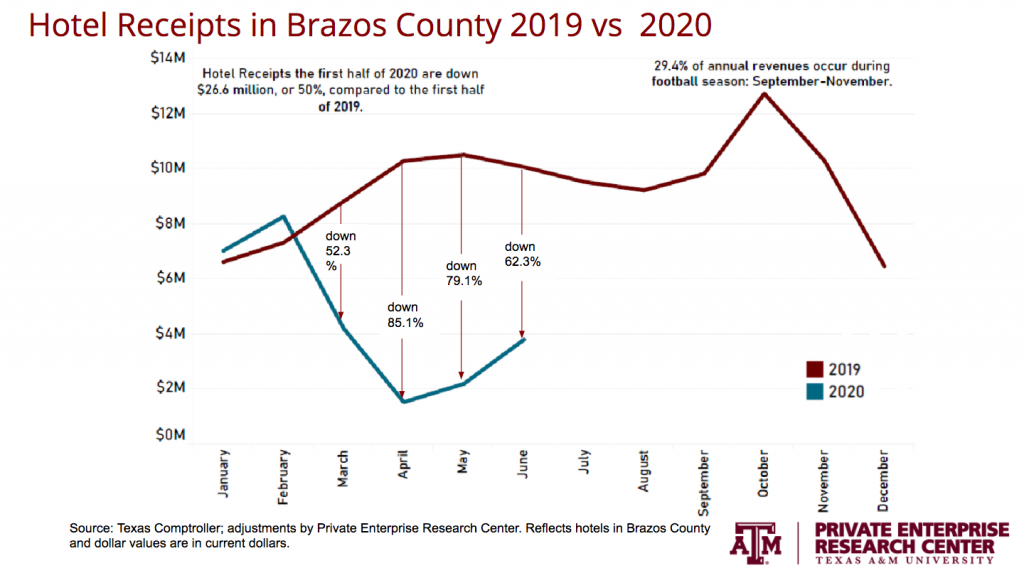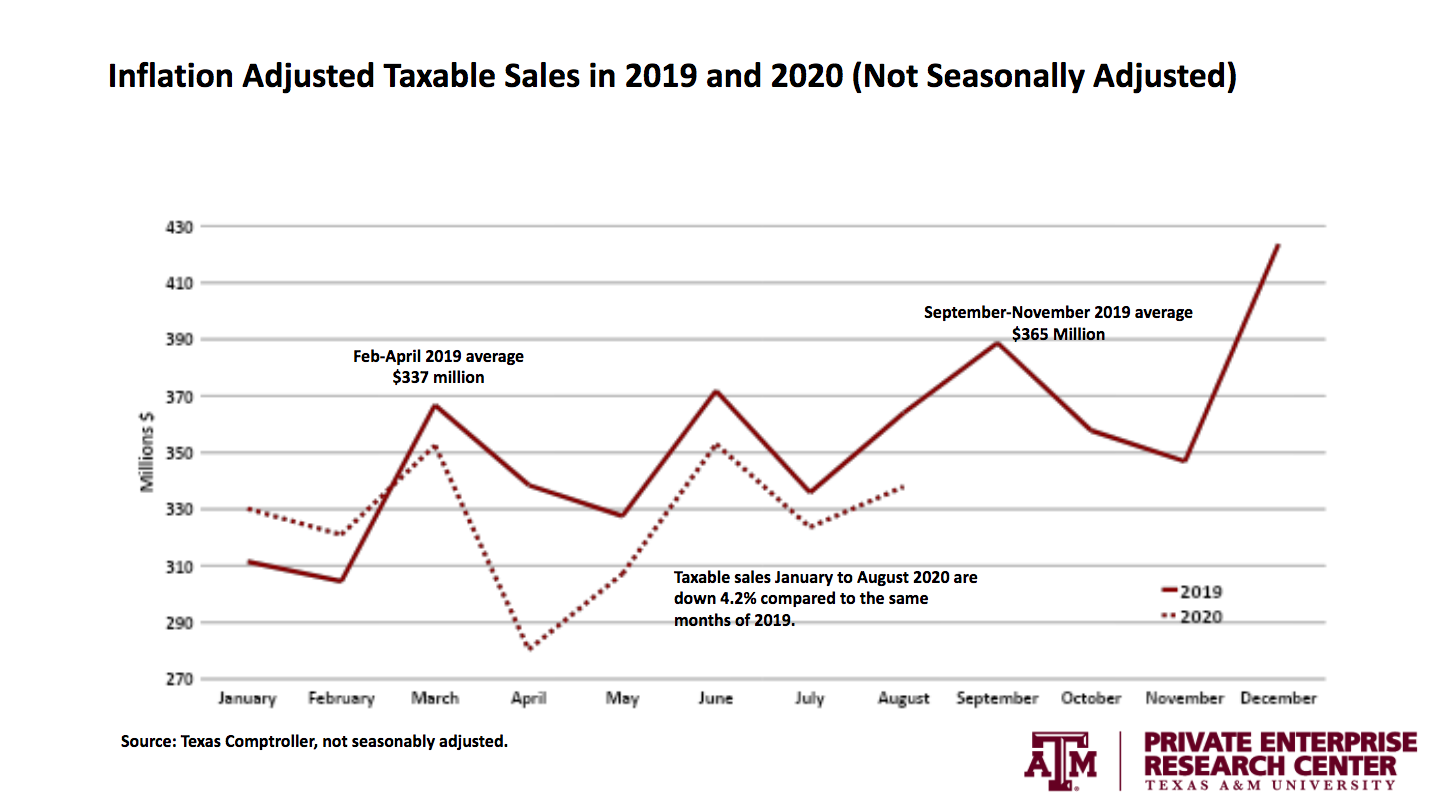Forecasting the Economy in a Post-COVID World
With everyone’s eyes on the fast approaching new year, it's more important than ever to examine the past and present of the economy before looking to the future.

By Amber Francis ‘22
As the holiday season ramps up, many are wondering what the future will bring. 2020 has been a year of unprecedented events, with peoples’ lives and livelihoods disrupted by the emergence of COVID-19.
The economy has reflected these disruptions. Economists are now using data from this year to predict the economic forecast of 2021 and what a post-COVID world might look like.
Travel and tourism, along with other leisure activities, are some of the industries hardest-hit by the pandemic, according to Dennis Jansen from the Department of Economics at Texas A&M University. This is especially apparent in areas like Bryan-College Station, that depend heavily on the traffic from visiting family members, business meetings, and college events that draw big numbers for local restaurants, hotels, and the Easterwood Airport.

Hotel receipts for Brazos county are down compared to 2019. COVID-19 has hit industries that rely on travel, such as tourism and hospitality, particularly hard.
“When a semester is going on, hotel receipts are high. We have events: Parent’s Day, Ring Day, a whole bunch of other things happening. In the fall, those numbers go up even higher because we have football season, and on those football weekends the hotels around Bryan-College Station are full. Things are much different this year; the numbers are way lower.”
Other indicators like taxable sales and retail sales didn’t fall through the floor the way tourism and travel did, but the numbers are still noticeably lower. Brazos County alone is down four percent in taxable sales compared to last year. While that may not sound like much, looking at the data from January and February makes the impact of this loss more clear.
“In those early months, the economy was doing well and 2020 was actually shaping up to be better than 2019,” said Jansen. “And then March happened.”
The decrease in taxable sales indicates a lack of business revenue. Businesses that are unable to recover from the loss of revenue are shutting down permanently. This lack of consumer spending also has massive implications for tax collection. A decrease in taxable sales means that sales tax collections are down, and this matters a lot for local governments.
“Bryan and College Station’s city governments rely on sales taxes, as does the Texas government. This affects Texas A&M’s budget, school teachers’ budgets, and all kinds of government-funded entities throughout the state,” Jansen stated. “The State Legislature is meeting in the spring and they’ll be looking at forecasts of lower tax revenues, including sales tax revenues. This is happening all over the state of Texas.”

Taxable sales in 2020 are consistently below the 2019 average despite a strong start in January and February.
During a time filled with stimulus checks and rent-freezes, it’s no surprise that the Office of Unemployment Insurance and Bureau of Labor Statistics reported that 26.9 million people nationwide filed for unemployment during the months of March and April. However, Jansen said employment and unemployment rates are the most telling and useful figures to look at in determining the country’s economic health. These indicators are relevant regardless of industry and have data available on a monthly basis.
“We focus on employment because of the obvious importance for people to have jobs, and because it’s a good indicator of overall economic health. If unemployment is high, things are bad for business; if they have to lay off their workers it means there isn’t much revenue coming in,” he said.
When it comes to business and economy, another phrase you may become familiar with is the United States’ Gross Domestic Product (GDP). Many people look at the country’s GDP as a reliable measure of economic standing, as well as an indicator to track current economic events. Unfortunately, the GDP only becomes available every three months, which means an information lag.
“Unemployment fell for the third quarter, but during the last month of the third quarter unemployment went up slightly,” Jansen explained. “GDP can’t tell you that because it is a number that only looks at the quarter as a whole. There is no monthly GDP number. It’s just not relevant to current events.”
Jansen’s words ring especially true when looking at local economies like Brazos County. The United States’ Bureau of Economic Analysis (BEA) only releases an annual number, with the most recent GDP data available from 2018. In all, GDP is good for studying history, but does little to help people follow what’s happening now.

Employment rates nationwide in 2020 took a sharp turn downwards during March, slowly recovering over the course of the summer as businesses began to reopen.
When looking at the topic of the United States’ economic future, Jansen recommends caution.
“There’s an old saying that warns, ‘Economic forecasters exist to make weathermen look good,’” Jansen joked. “So you should take what I’m about to say with a grain of salt. Essentially, I think the economy will continue to recover from the recession that hit us during March and April, but it’ll be slow.”
When parts of the economy began to reopen over the summer and some businesses resume operations, Texas recovered quickly, with the state unemployment rate falling. But there’s limits to that. The Congressional Budget Office projects that it will be several years before the nation’s GDP returns to the level it was in 2019. A return to normalcy in economic terms is estimated to be anywhere from late 2021 to 2022.
Jansen believes the recovery will likely be a bit slower for a couple of reasons—namely, peoples’ behavior and their choices, which are often motivated by the very real fear of getting sick. Until these behaviors and decisions change, people will continue to choose not to dine at restaurants, book airline travel, or participate in tourism.
“In terms of the economy returning to what it was back in January, to pre-COVID, until we have a safe and effective vaccine that is able to be widely taken, we are going to be a long time recovering from this,” Jansen stated. “I believe that some of these forecasts you see may be a bit too pessimistic, but it’s not ending soon.”
Slow and steady seems to be the pace of the COVID economic recovery race.
“The relatively easy work of the recovery has happened,” Jansen said. “It’s just going to be a slower process from here on out.”
